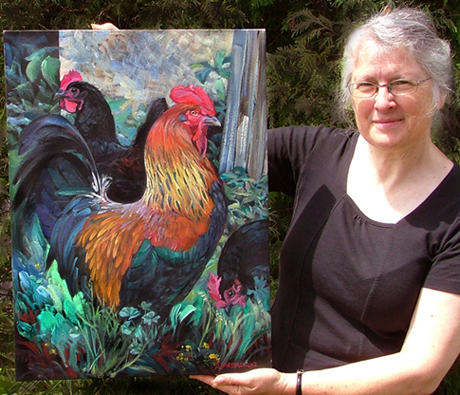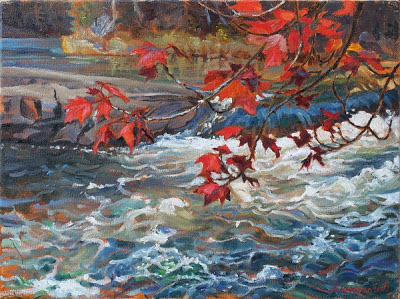Popular Subjects
As a young teen I was already headed in this direction. I can remember stating to my family that the three things I was least interested in were
Tulips, Monarch Butterflies, and Niagara Falls. Since then I've learned more about Tulips, become fascinated by the life of the Monarch, and have come to love the Niagara Gorge.... but I still feel the same way about all three as popular subjects. They've "already been painted!" I know now that there's always something more to learn even about popular subjects, and so I challenged myself to make an elegant portrayal of a rooster and his hens. I was especially pleased when I learned that this rooster's plumage is the original pattern of his wild ancestor the Red Jungle Fowl!
Tulips, Monarch Butterflies, and Niagara Falls. Since then I've learned more about Tulips, become fascinated by the life of the Monarch, and have come to love the Niagara Gorge.... but I still feel the same way about all three as popular subjects. They've "already been painted!" I know now that there's always something more to learn even about popular subjects, and so I challenged myself to make an elegant portrayal of a rooster and his hens. I was especially pleased when I learned that this rooster's plumage is the original pattern of his wild ancestor the Red Jungle Fowl!
One of the mantras, or memes, of both science and high art is that one should constantly be moving into new territory and discoveries, and both Fred and I seem to be infected by this meme. In the case of urban Art the mandate to seek novelty leads to installations and new media of various kinds, and painting has taken the back seat to other media. In a modern context, "Art" is no longer what you buy, but what you experience, and "cutting edge artists" in all media have come to be supported by grants rather than by sales of their work. This leaves painters like myself challenged to find a way to climb out of the back seat. Wall space in people's homes is increasingly taken up by prints and wide-screen monitors, and although images of art are appreciated, most people are not "art buyers".
In natural history art, there's no need to go beyond the traditional media, since there's so much more message available in the nearly infinite subject matter - the phylogenetic histories and productions and interactions of life. Yes, Virginia, I developed my craft by drawing Horses, but there are multitudes of artists portraying horses. I remember being offended when my Grade 8 teacher told me that I would not always be drawing horses. As he predicted, I did indeed move on as my love of nature opened up the world to me.
By the time I finished high school I'd already done two biological illustrations, and decided that since drawing and painting was my favorite tool for learning, as a biological illustrator I would continue to learn! My first job after art school was as an illustrator at the National Museum of Natural Sciences in Ottawa, drawing one representative of each phylum of all the animals on earth - what an eye-opener! Then I married a biologist. Following Fred about, one can't keep from learning about organisms one hadn't previously noticed! Because Canadian Nature Notebook (published in 1979) was written and painted from what we'd seen in particular habitats, we often hear that the book is more useful than many field guides full of plants and animals that might NOT be seen. Fred and I both love to teach, and the idea of teaching people things about nature as we discover them ourselves has increasingly taken over my productivity as an artist.
But on the other hand, we resolved long ago that, in order to curb our ecocentric tendencies, we'd, as much as possible, do the things that we were asked to do, rather than what had o-ccurred to us. Just as Fred is willing to survey woodlots for Black Rat Snake habitat, I'm prepared to paint conventional subjects whenever they're called for - farm animals, game animals, deceased relatives, babies, pets, barns, houses, vehicles, favorite scenes - if you've got access to the site or good reference materials, send in the commission!
We've been saying for some time that the reason our field work hasn't been able to support itself fiscally is that we're doing the things that need to be done - and that the necessity is demonstrated both by the thanks we receive for doing it, and by the lack of funding to support it. Every time I happen to do a painting of the kind of subject that others paint for a predictable market, there's a bit of a clamour (or a tactfully phrased suggestion) that concentrating on such subjects might be a way to stabilize our family income.
Although popular subjects don't appear in the body of my exploratory work, I enjoy the cooperative effort of making art for people who would like to have a painting done by me of a particular subject - consider this an advertisement for such commissions!




I didn't know you did commissions, Aleta. That's wonderful news.
ReplyDeleteFor several years, I told my husband I wanted a Golden Retriever, specifically an adult female Golden Retriever. He would say, "Oh, yes, some day, some day."
When we adopted Lindy from a no-kill rescue society, they told us she had come to them from the SPCA because everyone there agreed such a sweet dog shouldn't be put down. The first time we met her, she decided my husband was her person. The next time we saw her, she greeted us enthusiastically, as if to say, "I knew you'd be back."
When we went out to bring her home, she jumped into the car as soon as the door opened, and settled herself in the wheel-well on the driver's side because it smelled most like him.
She was only my dog for a few days, as far as he was concerned. In that time she won him over completely, and they adore one another.
Of course no one knows how old she really is, although the vet thought she was four when we adopted her, which would make her seven now, but she could be as old as ten, because the hair on her face is going white. We just don't know.
What I do know, however, is that my husband will be devastated when her time comes.
I know Golden Retrievers are "ordinary subjects" equal to Monarch Butterflies and maybe even Niagara Falls, but could you please tell me what price you would want for a painting of our Lindy?
Would you prefer to work in oil or watercolour? Please let me know.
I can send you many digital photos of her, of course, and I'd like the painting to be no larger than 5x7, because I so admire the botanicals you do on small canvases.
Sincerely,
Kay Davies (ourcopyeditor@gmail.com)
Wow. great work there. I like the colors a lot. Looks like it was a picture, not a painting. Nice. Really nice.
ReplyDeletePainters Ottawa
On painting horses, I recall an artist told me that if you are looking to make a bit of money, don't paint children. The parents want the portrait to look just like the child, and also for the child to look beautiful, which are often conflicting goals. And don't paint dogs because a dog looks like a dog to you, but the owner will be familiar with every last freckle and will be hypercritical if you get one spot out of place. You should paint horses, because horse people are happy with capturing the essence and are also crazy, and will pay big bucks for anything to do with their horses, even if they are on the verge of starving themselves!
ReplyDeleteIt's not too late to paint Niagara Falls. Wolf Kahn just got around to it in 2006, when he was about 78 (Horseshoe)!
Love your work.